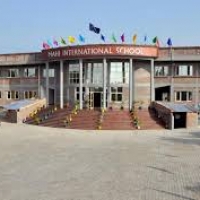Mahi International School in Agra, Uttar Pradesh Admission, Fees Structure

Where is Mahi International School ?
Mahi International School is Located in Agra , Uttar Pradesh, India
Address of Mahi International School, Agra
Agra-Gwalior Road
NH-3 Kheragarh
Agra
Uttar Pradesh
+91-7533922333
+91-7534922333
info@mahischool.ac.in
How do I contact Mahi International School?
Call at +91-7534922333 to contact Mahi International School
About Mahi International School
Mahi international School is Unique in its league. The abiding obsession at Mahi is to make learning inspiring for children, including the desire to enquire, explore and experience. For, we are a school which believes that education lies beyond the textbook and that true learning comes from self enquiry and research, from discussion, from reading and from encouraging the natural curiosity of young minds. There is day schooling along with boarding facilities for both boys and girls with the capacity to accommodate 400 and 100 students respectively, thereby combining both day scholars and residential scholars. The school has a dedicated faculty of highly qualified and efficient teachers, who use modern techniques of teaching. The school provides best-in-class infrastructure facilities. The learning needs of each student are met in an environment that is supportive and affirming. Peer tutoring, remedial and enrichment classes are regularly conducted to optimize learning outcomes. Besides this student’s life is enriched by a series of co-curricular activities which have an important role to play not only in enriching the curriculum but they also help to boost children’s self-esteem and self-confidence thus making learning exciting through motivational activities for attaining academic excellence.
In a brief interruption in Mughal rule between 1540 and 1556, Sher Shah Suri, established the short lived Sur Empire Agra was the capital of the Mughal Empire from 1556 to 1648, under the Mughal Emperors Akbar, Jahangir and Shah Jahan, after which Shah Jahan shifted the capital to Delhi The Mughal Empire saw the building of many monuments, especially Taj Mahal The city was later taken by the Jats and then Marathas and later still fell to the British Raj Agra is a major tourist destination because of its many Mughal-era buildings, most notably the Taj Mahal, Agra Fort and Fatehpur Sikri, all of which are UNESCO World Heritage Sites.
Agra is included on the Golden Triangle tourist circuit, along with Delhi and Jaipur; and the Uttar Pradesh Heritage Arc, a tourist circuit of Uttar Pradesh, along with Lucknow and Varanasi Agra is in the Braj cultural region
The two major rivers of the state, the Ganges and Yamuna, join at Triveni Sangam in Allahabad and flow further east as Ganges Other prominent rivers are Gomti and Saryu The forest cover in the state is 609% of the state's geographical area The state is bordered by Rajasthan to the west, Haryana, Himachal Pradesh and Delhi to the northwest, Uttarakhand and an international border with Nepal to the north, Bihar to the east, Madhya Pradesh to the south, and touches the states of Jharkhand and Chhattisgarh to the southeast.
It covers 240,928 km2 (93,023 sq mi), equal to 734% of the total area of India, and is the fourth-largest Indian state by area Though long known for sugar production, the state's economy is now dominated by the services industry The service sector comprises travel and tourism, hotel industry, real estate, insurance and financial consultancies The economy of Uttar Pradesh is the fifth-largest state economy in India with ₹17.
94 lakh crore (US$250 billion) in gross domestic product and a per capita NSDP of ₹70,000 (US$980) There is highest unemployment rate in Uttar Pradesh The state ranks 35th among Indian states in human development index President's rule has been imposed in Uttar Pradesh ten times since 1968, for different reasons and for a total of 1,700 days The state has two international airports, Chaudhary Charan Singh Airport (Lucknow) and Lal Bahadur Shastri Airport (Varanasi).
Allahabad Junction is the headquarters of the North Central Railway and Gorakhpur Railway Station serves as the headquarters of the North Eastern Railway The High Court of the state is located in Allahabad Inhabitants of the state are called either Awadhi, Bagheli, Bhojpuri, Braji, Bundeli, Kannauji, or Rohilkhandi depending upon their region of origin Hinduism is practised by more than three-fourths of the population, with Islam being the next largest religious group Hindi is the most widely spoken language and is also the official language of the state, along with Urdu.
Uttar Pradesh was home to most of mainstream political entity that has existed in ancient and medieval India including Maurya Empire, Harsha Empire, Mughal Empire, Delhi Sultanate, Gupta Empire as well as many other empires At the time of Indian independence movement in the early 20th century, there were three major princely states in Uttar Pradesh- Ramgadi, Rampur and Benares The state houses several holy Hindu temples and pilgrimage centres Uttar Pradesh has three World Heritage sites and ranks first tourist destinations in India Uttar Pradesh has several historical, natural, and religious tourist destinations, such as Kushinagar, Kanpur, Ayodhya, Vrindavan, Mathura, Varanasi, Allahabad, Lucknow, Jaunpur, Noida, Meerut, Bareilly, Faizabad, Aligarh, Agra, Jhansi, Rampur, Raebareli, Saharanpur, and Gorakhpur.